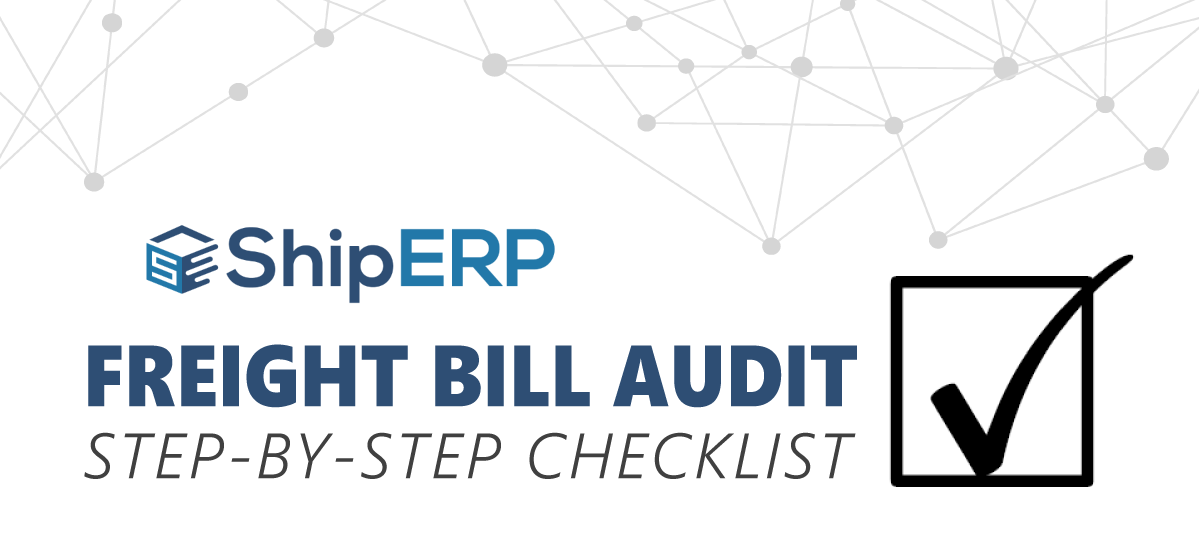
Step-By-Step: How Freight Bill Auditing Works
Your company’s success depends on the efficiency of its shipping network. Companies are required to carefully keep track of their shipping costs to ensure it does not incur a loss. Are you set up for success? Follow this freight bill auditing checklist to set your company up for success.
A business’s main priority is to deliver the right product to the customer on time to build a lasting relationship. The second is to maximize the company’s bottom-line by shipping the product in a cost-efficient manner.
To achieve that, your business should be regularly executing a freight audit process to ensure accuracy. Keeping track of the data and its accuracy will lead you to make smart business decisions, grow the company, and increase profit margin.
Performing a freight bill audit will supply you with enough data to identify weak points and highlight ways for your business to improve overall performance.
FREIGHT BILL AUDIT STEP-BY-STEP CHECKLIST
Step 1: Collect and upload invoices
Centralize all your invoice data into an editable system online. You should be able to pull up past invoices when you need it promptly. Within your system, you should be able to sort your invoices by date, company, or other factors you need.
Step 2: Categorize invoices
To make it easier for you to analyze the invoices, group the freight bills by carrier and sort within the groups according to date from oldest to newest. You’ll be able to compare past and current freight charges and see if you’re paying more than needed for shipping.
Step 3: Verify the charges
Here’s the hard and long part in auditing your freight charges. Comb through the information for potential errors and ensure that you are performing the right steps.
- Accessorials: Freight carriers normally charge for additional services, like handling fees and delivery area fees. These services can be charged after the fact which means you should verify if these extra charges should be reduced or waived according to your freight contract with the specific carriers.
- Base Rate: Verify that the bill begins with the correct base rate, which can be the carrier’s established base rate or a third-party rate.
- Discounts: Verify that any contracted discounts are deducted from the invoice.
- Duplicates: Check for invoices with closely matching invoice numbers, identical or closely matching dollar amounts, and invoices paid by separate accounts. Any of these can be duplicate charges for the same shipment.
- Freight Classification: The National Motor Freight Classification defines your product within 18 classes. The classification is determined by the freight’s density, stowability, liability, and handling. Some classes are easier and cheaper to ship than others, so you could be overcharged if the freight is misclassified.
- Late Delivery: Depending on the specific shipping carrier, a late delivery means that your invoice charge could be voided or have a reduced rate.
- Taxes: Verify that the bill reflects the taxes applied from current tax law (locally and federally), and from customs feed and international tariffs if applicable.
- Total Amount: The last thing to do is to verify the total amount after reviewing the possible additions and/or reductions to the invoice.
Step 4: Analyze the data
Analyze your freight invoices and bills to make decisions that would improve your shipping efficiency and cut costs. Here are some goals to consider as your business grows and continues to ship products.
- Lower Turnaround Time: Turnaround time is the amount of time a freight carrier loads and unloads your shipments. High turnaround time means higher charges on your freight bill. Aim for lower turnaround time by being prepared for the carrier’s arrival and having your shipments ready for loading.
- Minimize Price Hikes: Price hikes are the norm for reasons like toll charges, seasonal rates, fuel, and duty increase. It’s essential to note down any unusual price hikes during your audit. There might be ways to minimize being hit with price hikes.
- Better Utilize Capacity: Carriers charge your business either by a full truckload or less than a truckload. You can reduce the number of required freight runs by utilizing the full capacity of the trucks. Make sure that your carrier optimizes shipments for you.
Step 5: Set benchmarks
Now that you’re aware of the many factors that affect the total dollar amount for a freight bill, it’s time to set your benchmarks to see how and where you’re spending money for shipping. By having all the data in front of you, you’ll have the knowledge to set realistic shipping goals for your business to strive towards.
Step 6: Consider automation
Shipping rates are affected by a myriad of factors like mileage, type of product, and fees associated with pickup/delivery. Not only that, each carrier presents the information differently, which makes keeping accurate track of freight invoices and bills difficult, especially if your business is doing it manually.
How can you perform freight bill audits accurately?
Save shipping costs and increase your business performance by automating your freight audits via shipping software solution or outsourcing.
At ShipERP, we offer a freight audit automation solution to improve efficiency and support data-driven decisions for your company. AuditERP is designed to alleviate your freight bill inconsistencies, especially for SAP environments. It integrates seamlessly with your SAP ERP and ShipERP shipping software, communicating directly with carriers, whether or not they operate on the SAP platform.


